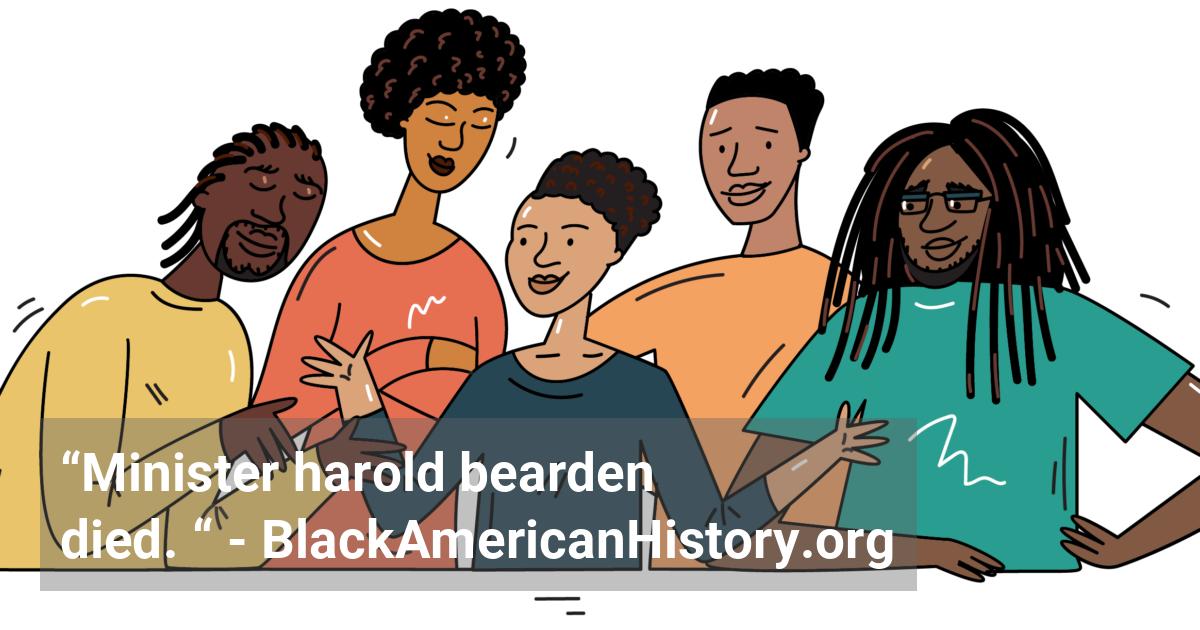Home / Full timeline / Harold Irwin Bearden, minister and civil leader, dies after suffering a stroke in Atlanta, Georgia, at age seventy-nine.
 Harold Irwin Bearden, minister and civil leader, dies after suffering a stroke in Atlanta, Georgia, at age seventy-nine.
Harold Irwin Bearden, minister and civil leader, dies after suffering a stroke in Atlanta, Georgia, at age seventy-nine.
1990 (Mar 19)
Harold Irwin Bearden, minister and civil leader, died after suffering a stroke in Atlanta, Georgia, at age seventy-nine. Bearden was born in Atlanta on May 8, 1910, to Lloyd and Mary Da Costa Bearden. He obtained an A.B. degree at Morris Brown College and a B.D. degree from Turner Theological Seminary (both in Georgia). Bearden was ordained a deacon in the African Methodist Episcopal (AME) Church in 1930 and an elder in 1931. He pastored the Big Bethel AME Church, one of the oldest and largest congregations in Atlanta, from 1951 to 1964. From 1960 to 1962, Bearden was an acting presiding elder of the A.M.E. Church and in 1964, he was consecrated a bishop in Cincinnati, Ohio. Bearden's first assignments upon elevation to the bishopric were in Central and West Africa. While there, he was elected president of the board of Trustees of Monrovia College in Liberia Upon his return to the United States, Bearden had church district assignments in Ohio and Texas before being named bishop of the Sixth Episcopal District in his native Georgia in 1976. He was president of the A.M.E. Council of Bishops in 1973-74. Bearden served as bishop in the Sixth Episcopal District of Georgia until 1980 and continued to serve on special assignments for his church until his retirement in 1984. While Bearden was president of the Atlanta chapter of the NAACP in 1958-59, a suit was filed to desegregate the Atlanta public schools and a federal court ordered desegregation on the city's buses. Bearden was one of several Black ministers who were arrested in 1957 for defying Georgia's bus segregation laws. He continuously used his Sunday radio broadcasts to chide both segregationists and Black accommodationists about Jim Crow practices in Atlanta and the nation, and he supported student sit-in demonstrations in the city in the 1960s. Bearden served as a director of the Atlanta University Center consortium of Black colleges and was a chairman of the boards of trustees at both of his alma maters, Morris Brown College and Turner Theological Seminary. The state senate of Georgia named him an outstanding citizen in 1978. In one of the eulogies for Bearden, Jesse Hill, president of the Atlanta Life Insurance Company and a trustee of the Big Bethel Church, said, "When the history of the turbulent '60s and the bi-racial progress of Atlanta is written, the name of bishop Harold I. Bearden then the dynamic, fearless pastor of Big Bethel A.M.E. Church, has to be placed up front." John Hurst Adams, the current senior bishop of the A.M.E.'s Sixth Episcopal district, remembers Bearden as a major influence in the life of the community. He was active in community development, the civil rights movement, and all aspects in the advancement of the community and especially aspects of Black American community unity."
References:
- • Hornsby, Alton. Chronology of African-American History: Significant Events and People from 1619 to the Present. Detroit: Gale Research, 1995.
